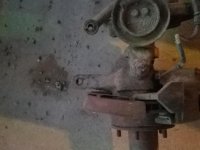ntsqd
heratic car camper
Think about what this linkage geometry is supposed to do and you'll see that mirroring the angle about the axle centerline will produce the opposite of the desired effect.
The way that Ford built it then is not how Ford would build a live front axle now. Bigger brakes drives the larger wheel sizes, but the Ackerman geometry can benefit from it as well.
The way that Ford built it then is not how Ford would build a live front axle now. Bigger brakes drives the larger wheel sizes, but the Ackerman geometry can benefit from it as well.
















